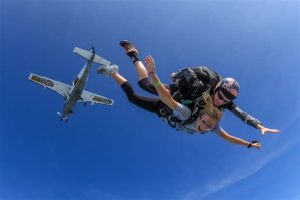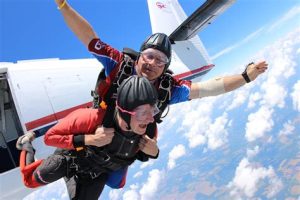Table of Contents
Discover the weight limit for tandem skydiving and embark on an exhilarating adventure like no other. Our expert instructors will guide you through the experience, ensuring your safety and enjoyment. Don’t miss out on the opportunity to defy gravity and feel the adrenaline rush of freefalling from the skies. Book your tandem skydive today!
Are you ready for the ultimate adrenaline rush? Imagine soaring through the sky at an exhilarating speed, feeling the wind rush past you as you freefall towards the ground. Tandem skydiving offers a thrilling adventure like no other, allowing you to experience the sensation of flying without any prior training or experience. However, before you take the plunge, it’s important to understand the weight limit restrictions for tandem skydiving. Following these weight guidelines ensures not only your safety but also the smooth execution of this extraordinary adventure.
Introduction
Welcome to our guide on the weight limit for tandem skydiving! If you’ve ever dreamed of experiencing the thrill of freefalling from a plane, tandem skydiving is an excellent option. However, it’s essential to understand the weight restrictions that come with this exhilarating adventure. In this article, we will provide you with all the necessary information regarding weight limits and guidelines to ensure a safe and enjoyable experience.
Importance of Weight Limit
The weight limit for tandem skydiving is crucial as it directly affects the safety and efficiency of the jump. The equipment used for tandem skydiving is designed to accommodate a specific weight range. Exceeding these limits can compromise the functionality of the gear and put both the instructor and participant at risk. Therefore, adhering to the weight limit ensures a smooth and secure skydiving experience.
Standard Weight Limit
The standard weight limit for tandem skydiving typically ranges from 200 to 240 pounds (90 to 109 kg). This weight includes the participant’s clothing and any additional gear they may be wearing. It’s important to note that weight limits can vary slightly between different skydiving centers, so it’s always best to check with your chosen facility for their specific guidelines.
Reasons for Weight Limit
There are several reasons why weight limits exist for tandem skydiving:
- Equipment Limitations: The tandem skydiving gear, including the harness and parachute, is designed to support a specific weight range. Exceeding these limits can strain the equipment and jeopardize safety.
- Freefall Speed: The weight of the tandem pair affects the freefall speed. Heavier individuals may experience faster speeds, which can impact stability during the jump.
- Landing Impact: The landing process involves slowing down the descent using the parachute. Heavier individuals generate more force upon landing, which requires greater skill and experience to manage safely.
Experience Level and Weight
While tandem skydiving does not require any prior experience, it’s important to consider your weight in relation to your skill level. Generally, individuals who are closer to the upper end of the weight limit may find the experience slightly more challenging due to the factors mentioned earlier, such as freefall speed and landing impact. However, this does not mean that heavier individuals cannot participate in tandem skydiving; it simply requires additional attention and expertise from the instructor.
Exceptions and Additional Fees
Skydiving centers may have certain exceptions or additional fees for participants who fall outside the standard weight limit. In some cases, individuals who exceed the weight limit by a small margin may be allowed to jump after an assessment by the instructor. However, this is solely at the discretion of the skydiving center and should not be assumed as a general rule. Additionally, there may be extra charges associated with exceeding the weight limit, as it may require special accommodations.
Pre-Booking Preparation
Prior to booking your tandem skydive, it’s essential to be aware of the weight limit and communicate your weight accurately to the skydiving center. Providing an accurate weight allows them to make the necessary arrangements and ensure your safety throughout the experience. It’s always better to be upfront about your weight to avoid any complications on the day of the jump.
Losing Weight for Skydiving
If you are currently above the weight limit for tandem skydiving and have your heart set on the experience, you can consider losing weight to meet the requirements. Engaging in a healthy diet and exercise routine can help you achieve your goal weight, making the experience more enjoyable and safer in the long run. However, it’s essential to consult with a healthcare professional before embarking on any weight loss journey.
Conclusion
Tandem skydiving is an incredible adventure that allows individuals to experience the thrill of flying through the skies. Adhering to the weight limit guidelines ensures the safety and smooth operation of the jump. Remember to check the specific weight limits at your chosen skydiving center and communicate your weight accurately during the booking process. By following these instructions and guidelines, you’ll be well-prepared to embark on an unforgettable tandem skydiving experience!
Preparing for Tandem Skydiving
Before your tandem skydive, it is important to ensure that you are properly prepared. One of the first things to consider is your clothing. It is recommended to wear comfortable attire, such as loose-fitting pants or shorts, and a t-shirt or long-sleeved shirt. Avoid wearing heavy jackets or bulky accessories that may interfere with the safety harness.
Understanding Weight Limitations
Knowing the weight limit set by the skydiving center is crucial when planning a tandem skydive. Typically, the weight limit for tandem skydiving ranges between 200 and 230 pounds (90 to 105 kilograms). This weight limit includes both the participant’s weight and the weight of the instructor. It is important to adhere to this limit to ensure a safe and enjoyable experience.
Assessing your physical condition
Prior to scheduling a tandem skydive, it is essential to assess your physical condition. It is important to be in good health and free from any medical conditions that may pose a risk during the activity. If you have any concerns about your health, it is advisable to consult with your healthcare provider before participating in tandem skydiving.
Communicating your weight accurately
When making a reservation for a tandem skydive, it is crucial to provide the skydiving center with your accurate weight information. This information allows the center to assign you an appropriate instructor and equipment. Failing to provide accurate weight details may result in an unsatisfactory experience or even a cancellation. Therefore, it is important to be honest and upfront about your weight.
Special Considerations for heavier individuals
In cases where a participant exceeds the standard weight limit, some skydiving centers may have specific weight restrictions or additional safety measures in place. These measures are in place to ensure a safe and successful skydive for everyone involved. This may include a higher minimum weight requirement for heavier individuals to guarantee a controlled descent.
Weight-related fees and restrictions
It is important to note that some skydiving centers may charge an additional fee for individuals exceeding a certain weight limit. Additionally, they may have certain restrictions in place. To avoid any surprises or misunderstandings on the day of your tandem skydive, it is crucial to inquire about any potential extra costs or restrictions beforehand.
Accommodation for weight variances
Skydiving centers understand that participants come in various shapes and sizes. Therefore, they often have equipment specifically designed to accommodate individuals within the set weight limit. This may include different-sized tandem harnesses or parachute systems. These accommodations ensure a comfortable and safe experience for individuals across different weight ranges.
Safety first
The weight limit for tandem skydiving is established with safety as the top priority. It ensures that the parachute system and instructor can handle the weight, allowing for a controlled and enjoyable experience. Adhering to the weight limit is crucial to guarantee a safe and memorable tandem skydiving adventure.
Note: Each skydiving center may have its specific guidelines and weight limits. To obtain the most accurate and up-to-date information regarding tandem skydiving weight limits, it is essential to contact the center directly.
Weight Limit To Tandem Skydive
Instructions:
-
Arrival: Please arrive at the designated meeting point at least 30 minutes before your scheduled tandem skydive. This will allow us enough time to complete necessary paperwork and provide you with a thorough safety briefing.
-
Weigh-In: Once you arrive, our staff will guide you to the weigh-in area. In order to ensure a safe and enjoyable experience for everyone, there is a weight limit for tandem skydiving. The maximum weight limit is 220 pounds (100 kilograms) for men and 200 pounds (90 kilograms) for women.
-
Weighing Process: Our team will use a calibrated scale to accurately measure your weight. Please remove any heavy items from your pockets and take off your shoes before stepping on the scale. It is important to provide an accurate weight measurement as it directly impacts the safety of your jump and the performance of the parachute system.
-
Weight Restrictions: If you exceed the weight limit for tandem skydiving, unfortunately, we cannot accommodate your jump. This is not only for your own safety but also for the safety of our instructors and the integrity of our equipment. We understand that this may be disappointing, but we prioritize the safety and well-being of our customers above all else.
-
Alternative Options: If you are unable to participate in a tandem skydive due to weight restrictions, we offer a range of alternative options to still enjoy the thrill of skydiving. You can consider a static line jump, where you will have your own parachute deployed automatically, or a wind tunnel experience that simulates the sensation of freefall.
-
Conclusion: We want to ensure that every tandem skydive is a safe and unforgettable experience. By adhering to the weight limit, we can maintain the highest standards of safety and provide you with the best possible adventure. If you have any concerns or questions regarding the weight limit or alternative options, please feel free to contact our customer service team.
We look forward to welcoming you for an incredible tandem skydiving experience!
Thank you for visiting our blog and taking the time to learn more about the weight limit for tandem skydiving. We understand that there may be some confusion or concerns regarding this topic, so we want to provide you with clear instructions and information to ensure your safety and enjoyment during this exhilarating experience.
Firstly, it is important to note that tandem skydiving involves a student skydiver being securely attached to a trained instructor who controls the parachute descent. This allows individuals with little to no skydiving experience to still enjoy the thrill of freefalling through the sky. However, due to safety regulations and equipment limitations, there are weight restrictions in place.
The weight limit for tandem skydiving can vary depending on the drop zone and the specific equipment being used. In general, most drop zones have a weight limit of around 220-230 pounds (100-105 kilograms) for men and 200 pounds (90 kilograms) for women. These limits are in place to ensure that the tandem instructor can safely handle the additional weight during the jump and landing phases.
If you are above the weight limit, it does not necessarily mean that you cannot skydive altogether. Some drop zones offer specialized equipment and training for individuals who exceed the standard weight limits. It is important to communicate with the drop zone and discuss your options in such cases. They may be able to accommodate you with alternative equipment or suggest other skydiving experiences that might better suit your needs.
In conclusion, while weight restrictions do exist for tandem skydiving, they are in place to prioritize your safety and the safety of your tandem instructor. It is crucial to adhere to these guidelines to ensure a smooth and enjoyable skydiving experience. If you have any further questions or concerns, we encourage you to reach out to your local drop zone for more information. Remember, skydiving is an incredible adventure, and we want everyone to have the opportunity to enjoy it to the fullest within the necessary safety parameters. Safe travels and blue skies!
.
Below are some frequently asked questions about weight limits for tandem skydiving:
-
What is the weight limit for tandem skydiving?
The weight limit for tandem skydiving varies depending on the drop zone and the equipment they use. However, it is typically around 220-240 pounds (100-109 kilograms) for most locations.
-
Can I go tandem skydiving if I am over the weight limit?
Unfortunately, most drop zones have strict weight limits for safety reasons. If you exceed the weight limit, you may not be able to participate in tandem skydiving. It is important to contact the drop zone beforehand to inquire about their specific weight restrictions.
-
Why do drop zones have weight limits for tandem skydiving?
Weight limits are in place to ensure the safety of both the jumper and the instructor. Exceeding the weight limit can put excessive strain on the equipment and decrease the overall stability during the freefall and parachute deployment. Drop zones prioritize safety above all else, which is why weight limits are strictly enforced.
-
Is there a minimum weight requirement for tandem skydiving?
Yes, there is typically a minimum weight requirement for tandem skydiving. It varies between drop zones but is usually around 100-120 pounds (45-54 kilograms). This requirement is in place to ensure that the parachute can properly deploy and provide a safe landing for the participants.
-
What happens if I am near the weight limit?
If you are near the weight limit, it is important to contact the drop zone and discuss your situation with them. Some drop zones may have special equipment or additional safety measures in place to accommodate jumpers who are close to the weight limit. However, it ultimately depends on the policies and capabilities of each specific drop zone.






